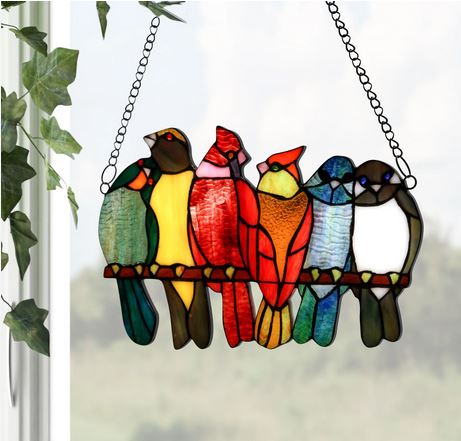Introduction to the stained Glass Bird
The stained glass bird has captivated collectors and art enthusiasts for centuries. With its delicate form and shimmering colors, this enchanting object is more than just a decorative piece; it tells a story of craftsmanship, culture, and symbolism. From exquisite handmade creations to mass produced replicas, glass birds have fluttered through history, weaving their way into the hearts of many.
As you explore the world of these remarkable artifacts, you’ll uncover tales that span generations and continents. Each glass bird carries with it whispers of tradition and artistry. Whether perched on a shelf or displayed in an exhibition hall, these little treasures invite curiosity and admiration.
Join us as we take flight into the rich history and cultural significance behind these stunning creations. Discover why they remain beloved by so many around the globe.
The Origin and Evolution of stained Glass Birds
Glass birds have a fascinating history that dates back to ancient civilizations. Early artisans experimented with glass-making techniques, creating delicate bird forms as decorative objects. These creations were often made for religious or ceremonial purposes.
As glass technology advanced through the centuries, so did the artistry involved in crafting these avian figures. The Renaissance period saw an explosion of creativity where skilled craftsmen began incorporating intricate details and vibrant colors into their designs.
Throughout the 19th century, glass birds became popular collectibles. They adorned mantelpieces and shelves across Europe and America, showcasing both artistic talent and craftsmanship.
Today, contemporary artists continue to innovate within this age-old tradition. Their work reflects modern aesthetics while honoring historical techniques. Each piece tells its own story a blend of culture, art, and individuality that captivates collectors worldwide.
Symbolism and Meaning Behind the Glass Bird
The stained glass bird often embodies freedom and transcendence. Its delicate form captures the essence of flight, symbolizing aspiration and hope.
Crafted from fragile material, it reflects the beauty found in vulnerability. This duality invites viewers to appreciate both strength and fragility in life.
In various cultures, these birds signify transformation. They remind us that change is essential for growth. The shimmering surface mimics light, evoking feelings of joy and serenity.
Additionally, many see glass birds as guardians against negativity. Their presence can promote peace within a space while serving as a charming decor element.
Artisans infuse personal meaning into each piece they create, making every glass bird unique to its maker’s vision. Whether displayed or gifted, their symbolism resonates deeply with those who encounter them.

Famous Glass Bird Collections and Exhibitions
Across the globe, several museums boast remarkable collections of glass birds. One notable example is the Corning Museum of Glass in New York. Their collection features exquisite pieces showcasing intricate designs and vibrant colors.
In Venice, Italy, the Murano Glass Museum highlights traditional craftsmanship with stunning glass bird sculptures that date back centuries. Visitors can witness artisans at work, creating these delicate forms right before their eyes.
The Victoria and Albert Museum in London has also curated an impressive array of contemporary glass birds. Here, artistry meets innovation as modern artists reinterpret classic themes through new techniques and materials.
Traveling exhibitions often display rare pieces from private collections or historical finds. Events like these offer a unique opportunity to see some truly exceptional examples of this art form up close. Each exhibition tells a story woven into culture and history through every fragile feather crafted from glass.
How to Care for Your Own stained Glass Bird
Caring for your storied glass bird is essential to keep its beauty intact. Start by choosing a dedicated display area away from direct sunlight. This helps prevent fading and ensures your piece remains vibrant.
Dust regularly with a soft, lint-free cloth. Avoid harsh chemicals that can harm the delicate surface of the glass. If deeper cleaning is necessary, use lukewarm soapy water and rinse gently.
Handle with care, as these pieces can be fragile. When moving or dusting, support both the base and body to avoid any breakage.
For added protection, consider displaying it in a case or behind glass doors. This defends against curious hands or accidental bumps.
Check for any signs of wear over time. Addressing small issues early can help preserve your treasured glass bird for years to come.
The Role of stained Glass Birds in Different Cultures
Glass birds hold distinct significance across various cultures. In many European traditions, these delicate creations symbolize freedom and hope. They often grace window sills as reminders of the beauty found in nature.
In Middle Eastern art, glass birds reflect intricate craftsmanship. Their vibrant colors narrate stories of abundance and prosperity. These pieces are not just decor; they embody cultural heritage and artistry passed through generations.
Asian cultures view glass birds as symbols of luck and joy. They are frequently given as gifts during celebrations, representing wishes for happiness and harmony in the recipient’s life.
In Africa, some communities believe that glass birds serve a spiritual purpose. They act as totems or protectors, guiding individuals towards safety and wisdom on their journeys through life.
Each culture imbues its own story into these beautiful artifacts, making them treasuresthat transcend time and boundaries.
Conclusion:
As you delve into the enchanting world of the stained glass bird, it becomes clear that these delicate creations embody more than mere decoration. They represent a fusion of art and history, culture and craftsmanship. The journey through their origin reveals how they evolved over centuries, adapting to different artistic movements while retaining their symbolic significance.
From showcasing vibrant colors to capturing intricate designs, glass birds have found a special place in various cultures around the globe. Whether displayed in museums or cherished within private collections, each piece tells its own unique tale. Caring for your own glass bird can enhance its beauty and longevity, allowing you to preserve a fragment of this rich heritage.
